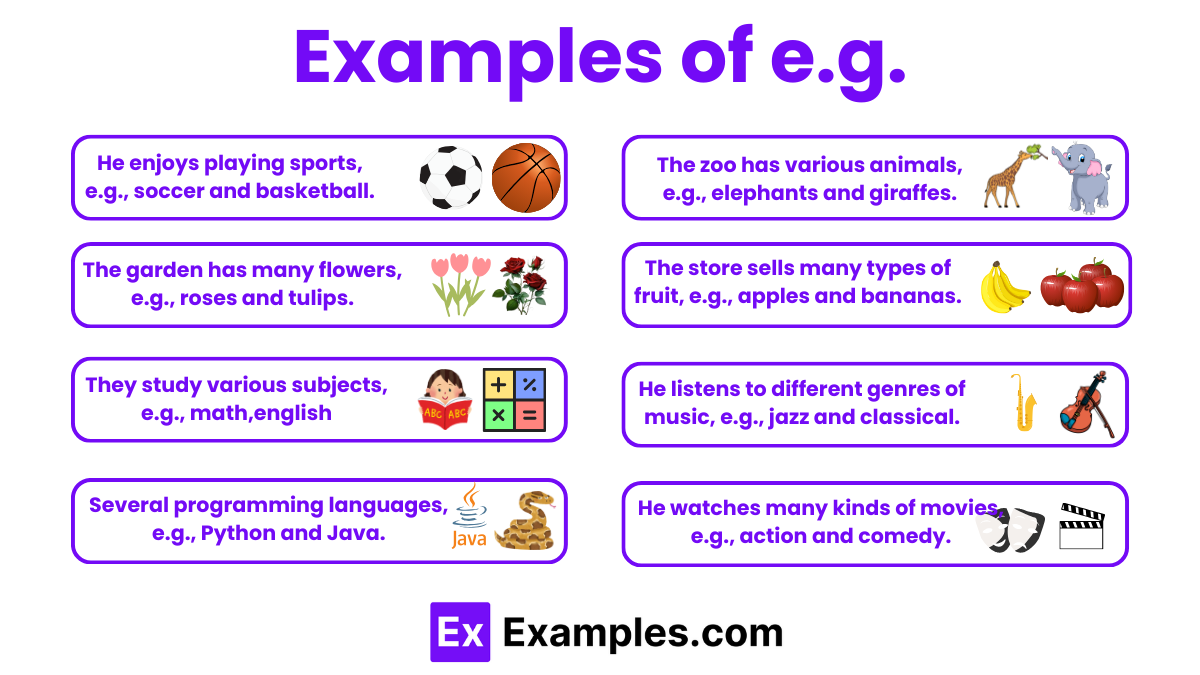20+ E.G Examples
E.g., an abbreviation for “exempli gratia,” stands for examples and is commonly used to introduce illustrations or instances. It helps clarify concepts, making explanations more vivid and comprehensible. For example, e.g., can be used to list items like fruits (e.g., apples, oranges, bananas) or to provide specific scenarios in academic writing. Understanding how to use e.g. correctly enhances communication by providing clear, concise examples that support and illustrate the main point.
What is “e.g.”?
E.g. stands for “exempli gratia,” a Latin phrase meaning “for example.” It is used to introduce one or more examples that illustrate a point, making explanations clearer and more specific. For instance, “Various fruits (e.g., apples, oranges, bananas) are nutritious.”
Examples of “e.g.”

- He enjoys playing sports, e.g., soccer and basketball.
- Many animals, e.g., lions and tigers, are carnivores.
- She loves to travel to various countries, e.g., France and Japan.
- The store sells many types of fruit, e.g., apples and bananas.
- He listens to different genres of music, e.g., jazz and classical.
- Several languages, e.g., Spanish and Italian, are derived from Latin.
- The garden has many flowers, e.g., roses and tulips.
- They study various subjects, e.g., math and science.
- Many professions, e.g., doctors and engineers, require advanced education.
- The restaurant offers several desserts, e.g., ice cream and cake.
- She reads various types of books, e.g., fiction and non-fiction.
- The school offers many extracurricular activities, e.g., drama and debate.
- He collects different items, e.g., stamps and coins.
- Several programming languages, e.g., Python and Java, are widely used.
- The zoo has various animals, e.g., elephants and giraffes.
- She enjoys different types of dance, e.g., ballet and salsa.
- They visited several cities, e.g., New York and Los Angeles.
- The company produces various products, e.g., electronics and furniture.
- He watches many kinds of movies, e.g., action and comedy.
- The library has a range of materials, e.g., books and magazines.
When to Use “e.g.”
- Providing Examples – Use “e.g.” when you want to give specific examples to illustrate a general statement or idea.
- Clarifying Statements – Use “e.g.” to clarify a point by listing instances that fall under the category being discussed.
- Adding Variety – Use “e.g.” to add variety to your writing by showing the range of possibilities or options.
- Avoiding Lengthy Lists – Use “e.g.” to avoid lengthy lists by giving a few key examples instead of listing everything.
- Supporting Arguments – Use “e.g.” to support your arguments with concrete examples that strengthen your points.
- Simplifying Explanations – Use “e.g.” to simplify complex explanations by breaking them down into familiar examples.
- Enhancing Understanding – Use “e.g.” to enhance the reader’s understanding by making abstract concepts more tangible.
- Formal Writing – Use “e.g.” in formal writing, such as academic papers and business reports, to provide clear and concise examples.
How to Use “e.g.”
- Identify Examples – Choose specific examples that clearly illustrate the point you are making in your sentence.
- Place Before Examples – Use “e.g.” directly before the examples you want to include in your sentence.
- Separate with Comma – Always place a comma after “e.g.” to separate it from the examples listed.
- List Examples – Provide a list of examples that support or clarify your main statement or idea.
- Keep it Brief – Ensure the examples you list are concise and directly related to your main point.
- Use Correct Context – Ensure that “e.g.” is used in contexts where you want to provide examples, not explanations.
- Avoid Overuse – Use “e.g.” sparingly to avoid cluttering your text with too many examples.
- Check Grammar – Ensure the sentence remains grammatically correct after adding “e.g.” and the examples.
Difference between i.e. vs e.g.
| Aspect | i.e. | e.g. |
|---|---|---|
| Meaning | “That is” or “in other words” | “For example” |
| Usage | Used to clarify or restate something more precisely | Used to provide one or more examples |
| Context | Provides a specific explanation or definition | Offers illustrative examples |
| Comma | Followed by a comma | Followed by a comma |
| Example | She is a doctor, i.e., a medical professional. | She likes fruits, e.g., apples and bananas. |
| Latin Origin | “Id est” | “Exempli gratia” |
| Scope | Narrows down the meaning | Broadens or exemplifies the meaning |
| Specificity | Indicates a specific item or concept | Indicates a variety of possible examples |
When is e.g. used?
e.g. is used to introduce specific examples.
How is e.g. punctuated?
e.g. is followed by a comma.
Can e.g. be used in formal writing?
Yes, e.g. is acceptable in formal writing.
Is e.g. the same as i.e.?
No, e.g. provides examples, while i.e. clarifies.
Should e.g. be italicized?
No, e.g. is not typically italicized.
Can e.g. start a sentence?
Yes, e.g. can start a sentence.
Do you capitalize e.g.?
No, e.g. is not capitalized.
Is there a space after e.g.?
Yes, there is a space after e.g.
How do you read e.g. aloud?
You read it as “for example.”



